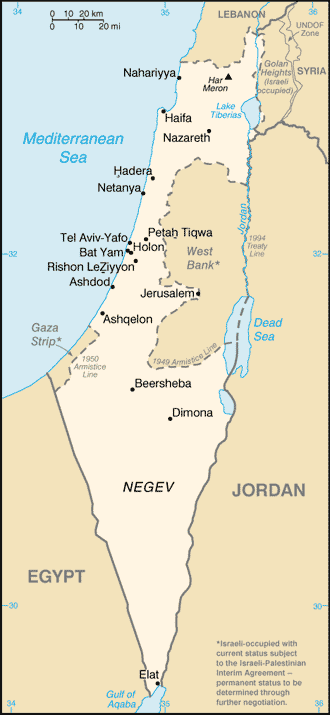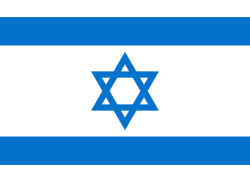Israel
Related Categories:
 Akhlah: Israel Symbols and their Meanings
Akhlah: Israel Symbols and their MeaningsAkhlah's introduction of Israel for children. The symbols of Israel and what the meanings are behind them.
www.akhlah.com/
Approval of a third emblem, the Red Crystal, to identify relief and emergency workers.
news.bbc.co.uk/2/
The Magen David (Shield of David), the six-pointed star made of two triangles, appeared according to Jewish tradition on the shield of King David.
www.fotw.us/flags/il.html
The State of Israel was created in 1948. The population today is over seven million, with a Jewish majority. While it is home to both Jews and Arabs, it is the world's only Jewish state.
en.wikipedia.org/
Of the approximately 6.35 million Israelis in 2005, about 4.86 million were counted as Jewish, though some of those are not considered Jewish under Orthodox Jewish law. Since 1989, nearly a million immigrants from the former Soviet Union have arrived in Israel, making this the largest wave of immigration since independence. In addition, almost 50,000 members of the Ethiopian Jewish community have immigrated to Israel, 14,000 of them during the dramatic May 1991 Operation Solomon airlift. 35.3% of Israelis were born outside of Israel.
The three broad Jewish groupings are the Ashkenazim, or Jews who trace their ancestry to western, central, and eastern Europe; the Sephardim, who trace their origin to Spain, Portugal, southern Europe, and North Africa; and Eastern or Oriental Jews, who descend from ancient communities in Islamic lands. Of the non-Jewish population, about 68% are Muslims, about 9% are Christian, and about 7% are Druze.
Education is compulsory from age 6 to 16 and is free up to age 18. The school system is organized into kindergartens, 6-year primary schools, 3-year junior secondary schools, and 3-year senior secondary schools, after which a comprehensive examination is offered for university admissions. There are seven university-level institutions in Israel, a number of regional colleges, and an Open University program.
With a population drawn from more than 100 countries on 5 continents, Israeli society is rich in cultural diversity and artistic creativity. The arts are actively encouraged and supported by the government. The Israeli Philharmonic Orchestra performs throughout the country and frequently tours abroad. The Jerusalem Symphony and the New Israel Opera also tour frequently, as do other musical ensembles. Almost every municipality has a chamber orchestra or ensemble, many boasting the talents of gifted performers from the countries of the former Soviet Union.
Israel has several professional ballet and modern dance companies, and folk dancing, which draws upon the cultural heritage of many immigrant groups, continues to be very popular. There is great public interest in the theater; the repertoire covers the entire range of classical and contemporary drama in translation as well as plays by Israeli authors. Of the three major repertory companies, the most famous, Habimah, was founded in 1917.
Active artist colonies thrive in Safed, Jaffa, and Ein Hod, and Israeli painters and sculptors exhibit works worldwide. Israel boasts more than 120 museums, including the Israel Museum in Jerusalem, which houses the Dead Sea Scrolls along with an extensive collection of regional archaeological artifacts, art, and Jewish religious and folk exhibits. Israelis are avid newspaper readers, with more than 90% of Israeli adults reading a newspaper at least once a week. Major daily papers are in Hebrew; others are in Arabic, English, French, Polish, Yiddish, Russian, Hungarian, and German.
www.state.gov/r/
Introduction
About
Contact
Symbols in The News
Interpret this Symbol
AAC
African
AI
Alchemy
Alphabets
Ancient
Animal Symbolism
Architecture
Art
Articles
Astrology
Baha'i
Blissymbolics
Blueprint Symbols
Buddhist
Celtic Symbols
Cemetery
Chinese Symbols
Christian
Circle
City
Codes
Color
Conlangs
Crop Circles
Danger
Da Vinci Code
Designing Logos
Dictionaries
Dreams
Education
Egyptian Symbols
Electrical
Emoticons
Find Images
Fonts
Food
Fraternity
Hamsa
Healing
Heraldry
Hermetic
Highway Signs
Hindu
History
Hobo
Holiday
Icons
iConji
Islamic
Jain Symbols
Japanese, Kanji
Jewish
Justice
Law
Literary Symbolism
Mandalas
Map
Masonic
Math, Number
Meaning of Names
Medical
Middle East
Military
Miscellaneous
Money
Music
Mythology
Native American
Playing Cards
Power
Psychology
QiQiiKhu
Reiki
Religious
Runes, Norse
Sacred Geometry
Scientific
Science Fiction
Sorority
Sports
Symbols in the News
Tattoos
ThirteenSymbols
Tree of Life
Ursprache
Videos
Visual Languages
Weather
Web Codes
Wicca
Words
Writing Systems
Braille
Coinherence
Coptic
Cuneiform
Easter Island
Etruscan
Happy Human
Hebrew
Kokopelli
Linear B
Lotus
Love Symbols
Mandorla
Moon Alphabet
Nine Pointed Star
Om
Oz
Phonetic
Scarab Beetle
Silent
Theosophy
Unifon
About
Contact
Symbols in The News
Interpret this Symbol
AAC
African
AI
Alchemy
Alphabets
Ancient
Animal Symbolism
Architecture
Art
Articles
Astrology
Baha'i
Blissymbolics
Blueprint Symbols
Buddhist
Celtic Symbols
Cemetery
Chinese Symbols
Christian
Circle
City
Codes
Color
Conlangs
Crop Circles
Danger
Da Vinci Code
Designing Logos
Dictionaries
Dreams
Education
Egyptian Symbols
Electrical
Emoticons
Find Images
Fonts
Food
Fraternity
Hamsa
Healing
Heraldry
Hermetic
Highway Signs
Hindu
History
Hobo
Holiday
Icons
iConji
Islamic
Jain Symbols
Japanese, Kanji
Jewish
Justice
Law
Literary Symbolism
Mandalas
Map
Masonic
Math, Number
Meaning of Names
Medical
Middle East
Military
Miscellaneous
Money
Music
Mythology
Native American
Playing Cards
Power
Psychology
QiQiiKhu
Reiki
Religious
Runes, Norse
Sacred Geometry
Scientific
Science Fiction
Sorority
Sports
Symbols in the News
Tattoos
ThirteenSymbols
Tree of Life
Ursprache
Videos
Visual Languages
Weather
Web Codes
Wicca
Words
Writing Systems
Braille
Coinherence
Coptic
Cuneiform
Easter Island
Etruscan
Happy Human
Hebrew
Kokopelli
Linear B
Lotus
Love Symbols
Mandorla
Moon Alphabet
Nine Pointed Star
Om
Oz
Phonetic
Scarab Beetle
Silent
Theosophy
Unifon

